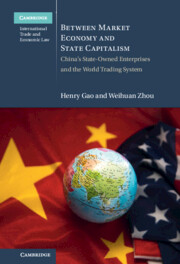 Between Market Economy and State Capitalism
Between Market Economy and State Capitalism Book contents
- Between Market Economy and State Capitalism
- Cambridge International Trade and Economic Law
- Between Market Economy and State Capitalism
- Copyright page
- Contents
- Figures and Tables
- Foreword
- Preface and Acknowledgements
- Table of Cases
- Abbreviations
- 1 China, State Capitalism and the World Trading System
- 2 The Evolution of China’s Reforms of State-Owned Enterprises (1978–2020)
- 3 State Capitalism in China’s Accession to the WTO
- 4 The Limits of General WTO Rules
- 5 The Potential of WTO Rules on Industrial Subsidies and China-Specific Obligations
- 6 Emerging Approaches to Regulating State-Owned Enterprises
- 7 Tackling China’s State Capitalism
- 8 Conclusion
- Index
1 - China, State Capitalism and the World Trading System
Published online by Cambridge University Press: 10 November 2022
- Between Market Economy and State Capitalism
- Cambridge International Trade and Economic Law
- Between Market Economy and State Capitalism
- Copyright page
- Contents
- Figures and Tables
- Foreword
- Preface and Acknowledgements
- Table of Cases
- Abbreviations
- 1 China, State Capitalism and the World Trading System
- 2 The Evolution of China’s Reforms of State-Owned Enterprises (1978–2020)
- 3 State Capitalism in China’s Accession to the WTO
- 4 The Limits of General WTO Rules
- 5 The Potential of WTO Rules on Industrial Subsidies and China-Specific Obligations
- 6 Emerging Approaches to Regulating State-Owned Enterprises
- 7 Tackling China’s State Capitalism
- 8 Conclusion
- Index
Summary
Chapter 1 introduces the main theme of the book, that is, challenging the conventional wisdom that the existing WTO rules are inadequate to address China’s state capitalism and demonstrating that China’s WTO-plus obligations, coupled with the general rules on subsidies, do provide ways to address the problem. It also provides summaries of the chapters to explain the structure of the arguments in the book.
Keywords
- Type
- Chapter
- Information
- Between Market Economy and State CapitalismChina's State-Owned Enterprises and the World Trading System, pp. 1 - 12Publisher: Cambridge University PressPrint publication year: 2022
